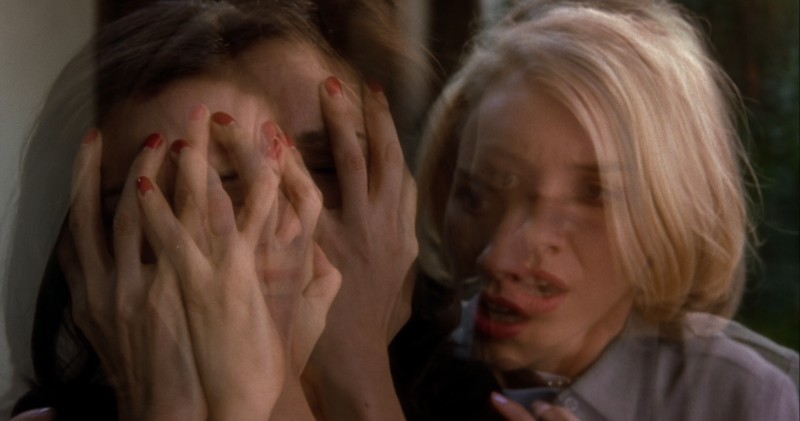Mulholland Drive is dense, enigmatic, and frequently bewildering, yet stands as one of David Lynch’s most emotionally resonant pictures.
One of the main things you need to take away from Mulholland Drive, David Lynch’s oft-heralded neo-noir masterwork, is that people love analysing Mulholland Drive. Every critic worth their salt has thrown their weight behind one interpretation or another of the film’s open-ended story, and a YouTube search for “Mulholland Drive explained” yields several explanatory video essays with 6-figure view counts. And why not? Lynch sits in that critic-friendly sweet spot, straddling mainstream box office figures and avant-garde sensibilities, a director whose idiosyncrasies and cinematic tics operate in a language all their own in the modern western canon. In Mulholland Drive, he yields up the most intriguing puzzle box of his career, a movie that tells just enough of a coherent story at face value to draw both the critic and the casual viewer alike into a desperate scramble for meaning.
Initially, the film revolves around the doomed romance of Betty (Naomi Watts) and Rita (Laura Harring). When Rita wakes up from a car crash, stumbling into an empty house below the Hollywood hills, she comes across Betty, whose uncannily wide-eyed optimism propels the pair through an increasingly malevolent cobweb of gangsters, hitmen, and cabaret singers. Running in parallel is the story of director Adam Kesher (Justin Theroux), who finds the casting of his film slowly but surely wrested out of his control. As these threads begin to intertwine with multiple others, set running as abruptly as they come to an end, the dreamlike state Lynch has conjured becomes increasingly nightmarish, before a sharp, violent break shakes the events back into the world of reality – or, in some interpretations, further into the nightmare.
Famously, Lynch abhors most close critical evaluation of his work. He is more than willing to provoke conversations, inviting any and all interpretations of his most abstract films, but his outright refusal to return concrete interpretations is part of what keeps the Mulholland Drive analysis industry in business. He is happy to provide breadcrumbs; the 10 questions included in the DVD of the film are designed to foster a closer relationship with one’s own interpretation of the film, rather than shepherd a viewer down a fixed and pre-determined path.
His approach to criticism belies his fundamental approach to filmmaking as a whole: when the language of cinema is placed at your disposal, and you create these emotionally rich stories that speak beyond what mere language can say, the act of forcing these stories to exist in the medium of words strips them of their power. As Lynch is fond of saying, “the film is the thing” – no interpretive think piece could ever quite replicate what has already been said on screen.

And Lynch, more than most other mainstream directors in the western canon, is more than willing to take advantage of the full semiotic toolkit he has at his disposal. His joyous intermingling of the conscious narrative with the subconscious – tangential vignettes and cameos that exist in no immediately obvious relation to the primary plot – force the viewer to act as detective themselves, transforming anything close to a traditional narrative into a puzzle that actively resists direct solution. Lynch’s use of imagery that seems projected directly from the subconscious is much more concerned with a sense of tonal consistency than a strict adherence to the plot and may immediately bewilder, but when these images are so consistently virtuosic, we find ourselves happy to sit in a state of understanding slightly behind the film’s own narration.
These stand-out moments, where the emotional resonance of on-screen events can surpass any attempt at an intellectual conception of the narrative, come frequently throughout. Naomi Watts, in particular, proves capable of scene-to-scene transformation that creates instantaneous and visceral unease at crucial points, separating her two roles into immediately distinct personalities. An early scene in a diner, sitting almost entirely discretely from the rest of the film’s events, does more to establish a tone of dread and anxiety than many thrillers accomplish in a two-hour runtime.
Rebekah del Rio’s rendition of Roy Orbison’s “Crying” marks a narrative point of inflection with a power that comes to define the film’s final third. Lynch is incredibly enthusiastic about capturing the full potential of these characters that flit in and out of the film’s story almost without a second glance, and it is in their own completely undefined fates in which Lynch lets his story of Hollywood unfurl.
In Mulholland Drive, we find the most meticulously crafted of all of David Lynch’s work, and yet a movie of seemingly deliberate haphazardness. Within that contradiction lies the line that the director has walked for his entire career. Wilfully enigmatic, the inapproachable nature of this film almost exists accidentally, a simple result of Lynch’s decision to focus more heavily on the emotional power that cinema holds instead of the narrative diligence to which it is traditionally forced to adhere.
Even within this puzzle lies, perhaps, one of Lynch’s most seemingly coherent stories, and it is only bolstered by his willingness to allow it to remain out of the film’s spotlight. It is a masterful dissection of the nightmares that are contained within the city of dreams, and a milestone worthy of the respect it has garnered in one of the great 20th century oeuvres.
Mulholland Drive was released on October 19, 2001, and is now available to watch on digital & on demand, and to own on DVD & Blu-Ray.

